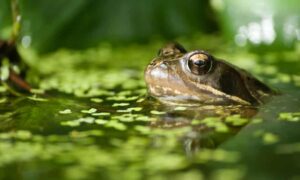
A pond boom is happening in Britain’s gardens as people try to halt wildlife loss by digging water sources for amphibians and other aquatic life.
Data from the Royal Horticultural Society shows a marked increase in sales of pond greenery; their online store had a 35% increase in sales of pond plants for 2023 compared with 2022.
Garden designers at Hampton Court Palace flower show have noticed the trend and many ponds are popping up among the exhibits at the show, which opens on Monday, as a result.
The floral marquee is normally home to perfectly symmetrical roses and other prize blooms, but this year they will share space with Lincolnshire Pond Plants.
Dawn Fisher, one of the company’s owners, said: “We have seen a real increase in the demand for pond plants that attract and support wildlife such as frogs, newts, dragonflies and damselflies. We’ve found that people are eager to create habitats that promote biodiversity and enhance their garden’s ecological balance.
“Creating a pond doesn’t have to be complicated. You can use a small washing up bowl and bury it in a border and only need three different plant varieties to support all manner of wildlife. Emergent plants that grow up and out of the water, like mini bulrushes, support dragonflies and damselflies; a rafting plant, like water forget-me-not, offers a platform for froglets and newts; and an oxygenating plant can prevent algae and stagnation. The great thing with ponds is that they don’t have to look weedy and overgrown, you can keep them quite neat and they’ll still attract wildlife.”
Pond plants can also stabilise the soil, prevent flooding, and filter water runoff to help keep natural waterways clean.
Tim Jennings, whose Four Season Sanctuary Garden is on display at Hampton Court, wants to show that a pond is easily incorporated into the back yard of any home. The design includes a small wildlife pond which provides drinking water for birds and attracts the insects they like to eat. It features entry and exit points for wildlife, different depths to allow for marginal plants and deeper rooting species, and is also deep enough to ensure it remains cool in hot weather.
